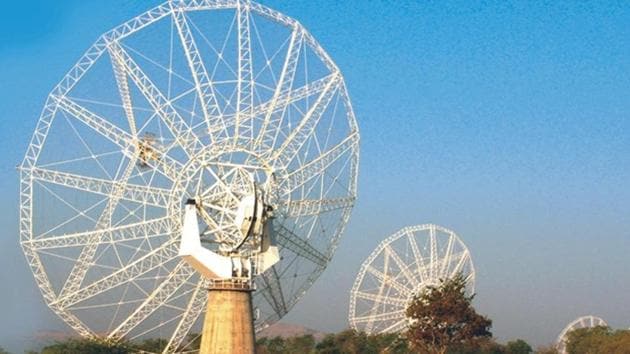GMRT observatory, located near Pune gets international recognition
With GMRT users covering over 40 countries and the fact that it was designed and built entirely in India, the IEEE India office and IEEE Pune section initiated a proposal to nominate the observatory for the prestigious international recognition
The Giant Metrewave Radio Telescope (GMRT), one of the world’s largest and low-frequency radio observatories, has been selected as an Institute of Electrical and Electronics Engineers (IEEE) Milestone facility. The facility is only the third IEEE Milestone recognition for an Indian contribution.

The previous two Indian contributions, recognised by the world’s largest technical professional organisation recognised in 2012, are for the pioneering work done by Sir JC Bose to demonstrate the generation and reception of radio waves in 1895, and for the Nobel Prize winning discovery of the scattering of light named “Raman effect” by Sir CV Raman in 1928.
With GMRT users covering over 40 countries and the fact that it was designed and built entirely in India, the IEEE India office and IEEE Pune section initiated a proposal to nominate the observatory for the prestigious international recognition. The proposal was submitted in cooperation with National Centre for Radio Astrophysics (NCRA) Pune , which is a part of the Tata Institute of Fundamental Research, to IEEE in early 2020, after an initial review of the history and accomplishments of the GMRT by a team from IEEE India.
After a rigorous review process, including appraisal by international experts and additional information from NCRA, the proposal was first put up before the history committee of the IEEE which cleared it for approval in October 2020. It was later submitted to the IEEE board of directors for final approval, which was granted on November 23.
Harish Mysore, senior director, IEEE India operations said, “IEEE has recognised 212 milestones worldwide for their scientific and engineering contributions. GMRT is the third IEEE Milestone in India. This IEEE milestone not only recognises the contributions of scientists and engineers of India, it also helps to attract young talent towards fundamental Science and Engineering.”
Prof Yashwant Gupta, centre director, NCRA, said, “It is indeed a very proud and special moment, not just for GMRT and NCRA (and the global astronomy community), but also for the entire Science and Technology fraternity in the country, to see a modern, made in India facility earn this international recognition. It is also a fitting tribute to the late Prof Govind Swarup, who was the driving force behind GMRT, and all the team members whose efforts over the last 30 years or so made GMRT a reality, culminating in the successful upgrade of the facility that we completed last year. We look forward with great anticipation to the IEEE Milestone dedication ceremony.”
Prof Toshio Fukuda, president and CEO of IEEE for circulation to the media said, “IEEE milestones recognise important landmarks in the global pursuit of excellence in Science and Engineering which have significantly advanced technology for the benefit of humanity. I am pleased that the Giant Metrewave Radio Telescope (GMRT) programme of India has been recognised as an IEEE milestone, acknowledging its contributions to the important work of exploring the universe through Radio Astronomy. I congratulate all of the scientists and engineers who have developed and operated GMRT with such great distinction.”
The IEEE Milestone will be formalised at a special dedication ceremony that will involve unveiling of the bronze citation plaque at the GMRT premises. The event is planned in 2021 after the Covid-19 pandemic situation allows ease of travel to India, and the IEEE president and other officials are expected to participate, in addition to several dignitaries from academia, industry and the Government of India.
Noted scientist Prof Raghunath Mashelkar while congratulating NCRA said, “This is fantastic news. My heartiest congratulations to the entire NCRA family, both the past and the present. What makes it special is the fact that the only other time this happened was when the pioneering work of JC Bose and CV Raman was recognised almost a century ago.”
Premier scientific body
IEEE is the world’s largest technical professional organisation dedicated to advancing technology in all areas related to electrical and electronics engineering. The IEEE Milestones programme honours significant technical achievements and excellence for the benefit of humanity found in unique products, services, seminal papers and patents, which have global or regional impact, in all areas associated with IEEE.
India’s pride
GMRT is one of the largest and most sensitive low frequency radio observatories in the world. It is operated by the National Centre for Radio Astrophysics (NCRA), Pune which is a part of the Tata Institute of Fundamental Research, Mumbai. It consists of an array of 30 antennas of 45 m diametre each, spread out over a 30 km region about 80 km from Pune, with sophisticated electronics and computing for processing the data from all the antennas. The facility was conceived of and proposed in the late 1980s, built and made operational during the 1990s, and opened for use by the global astronomy community in 2002.



